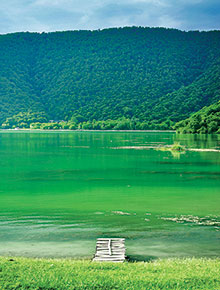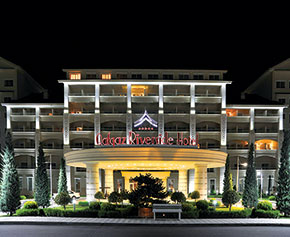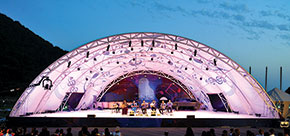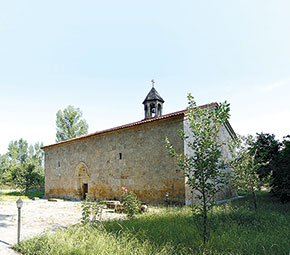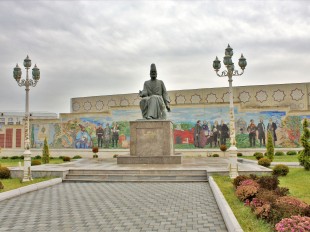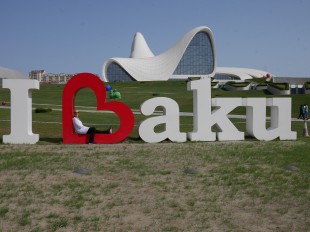In a series of articles for Visions, veteran travel writer Mark Elliott returns to destinations he first covered for his Trailblazer guidebook nearly two decades ago. In this piece he revisits the lush green lands of Qabala in north-central Azerbaijan and reflects on the changes there.
Photos by ELDAR FARZALIYEV
Cradled idyllically amid densely forested mountains, Qabala has blossomed into Azerbaijan’s prime rural getaway. It now has dazzling hotels that would seem indulgent even in Baku. The ravishing Heydar Aliyev Congress Hall has hosted international heads of state, who were able to fly in directly to Qabala’s new international airport. And in winter, Qabala is one of the country’s two ski resorts. Nowhere in Azerbaijan has risen so rapidly and professionally to the national challenge of developing tourist infrastructure in the provinces. But it wasn’t always so.
Far from it. Neither the Qabaland funfair/theme park nor the splendid Qafqaz Riverside Hotel had yet been built back in 2008 when I researched the fourth edition of my guide. I happened through again in 2010, astonished to find all the new construction that had gone on in just two years. And not only because of the vision and audacity in its funding. Amazingly the whole map had changed – even the river appeared to have been diverted somewhat to create the land on which to build the new resort area. And the mossy riverside forest, which had for many years been Qabala’s most obvious minor attraction, was now bypassed by a loop of new highway.
1997
Stretching my memories further back had me really scratching my head in wonder. At the time of my first visit in 1997, Qabala’s classic local mosque was still being used as the town’s museum – with an entrance fee of only 1,000 manats (a mere 20 qapiq). The appealing new museum building with its open-sesame ‘stone’ entrance portal was not even yet at the design stage. The town centre back then had only one rotting old hotel with grizzly bucket-flush toilets, which I described in the first edition of my guide as “unpleasant”. That was being very polite. All 54 rooms were, quite understandably, empty on the day I visited. Indeed the idea of tourism becoming a major attraction for Qabala seemed highly unlikely at that stage. While the 1990s certainly had more paranoid places – Qazakh was at that stage rabidly against having tourists nosing around – I had been advised in 1997 not to hang around too long in Qabala to avoid official ‘suspicion’. This warning seemed validated when my local friend/translator and I were stopped on the street and asked, albeit politely, about our reasons for being here. Go to Sheki, said the policeman. Tourists go to Sheki. They don’t come to Qabala.
The suspicions were probably based around the proximity of the Soviet-era Radio Location Station (RLS). Built in 1985 as part of the USSR’s missile defence radar-tracking system, this wedge-shaped concrete carbuncle was leased to Russia post-independence, despite yelps of protests from environmentalists and opposition politicians. As recently as 2007 the RLS site made international news when Russian President Vladimir Putin offered the US partial use of the facility as an alternative to what Russia saw as a politically provocative US move to build missile-watching stations in Eastern Europe. Of course by this stage Qabala was starting to relax about the RLS’s presence, much as Brits driving across the North York Moors pass RAF Fylingdales with barely a second thought. But during my first trip things felt distinctly uncomfortable, so I hurried on to the gorgeous Caucasian valley village of Laza folded into the steeply narrowing valley of the Damiraparanchai River. That’s when I first started to grasp Qabala region’s great tourist potential and I was excited to return.
2000
Return I did in 2000 on a day that just happened to be my birthday. This time I arrived from the north having hiked in with a small group of expats across the Caucasus Mountains in a two-day guided trek from Khinaliq. After a glorious first day, drenching rain had somewhat dampened our spirits as we slithered down the wet muddy hillsides towards Laza. Our guide was nervous that we make good time... Rain meant that the river level was rising constantly and the only way across was wading through on horseback. If we were too late the horse would be out of its depth and we’d be stranded. Bedraggled, we finally found a crossing place and managed to splash through the torrent. The hike, we assumed, was now successfully finished and we wandered happily into Laza looking forward to zipping back into Qabala for a good meal. Instead we were met by a barrage of furious questioning from some uniformed men. Laza, at this stage had become the base for Azerbaijani border guards checking for illegal visitors coming across the mountains from Chechnya or Dagestan. While it was clear that the officers were simply doing their job, shivering for an hour of interrogation seemed a somewhat unnecessary welcome. After all, we all had valid visas and clearly-stamped passports as having legally entered. Trying to mollify the guards, my Turkish friend pointed out that I was a travel writer and that they should be helping not hindering us. But this seemed to wind them up all the more. They demanded to see my notebook and – suspicious of all the maps – promptly confiscated it. I would only be allowed to get it back, along with all the laboriously noted waypoint details, if I could get a letter of request from a Baku ministry. Eventually we were released, but sadly Laza was essentially ‘closed’ to tourists thenceforth for over a decade, choking off one of Azerbaijan’s most appealing trekking routes. Hopefully all this will change in coming years – Laza is on the list of destinations to be developed as part of Qabala’s expanding cable car network. At least eventually.
2002
In 2002, given previous experiences, I was a little on edge for my next arrival in Qabala. At first my presence in town proved uneventful. But then I got to Sahil, a restaurant complex on the lake shore just to the east. Here I was assailed by a beetle-browed gentleman whose ample belly was heaving at his dark suit. He commanded me to come and explain to him what I was doing. Fearing another lengthy brush with the KGB my heart sank. But I’d misjudged things completely. He was a bigwig in the local executive and simply wanted to press on me the fullest weight of local hospitality. I was ushered to a table groaning with a range of local delicacies while he offered to answer any question I might have on the area. It was unquestionably a memorable afternoon, though memorable is probably the wrong term entirely, given the number of times I ended up toasting with ‘just one’ last vodka.
Around this time, a couple of small guesthouses had sprung up in the woodlands that today’s Qabala resort area now dominates. Despite the vodka I managed to find my way to a sweet little place overlooking the river, sleeping off the hangover as the only guest in residence. It was that day, exploring in a hazy state, that I headed into the mountains by the ‘wrong road’ to avoid Laza. Which is how I first discovered Durja. The taxi driver gritted his teeth seeming almost proud at his Lada Zhiguli’s masochistic ability to throw itself along a road that was more pothole than actual track. But Durja wasn’t far. And what a gem. Architecturally this was one of the most picture perfect villages I’d seen in Azerbaijan. Used only seasonally by semi-nomadic shepherd families, most of the homes were entirely deserted as the season was already late. People used to just shut up their homes and go with their flocks, said my driver. But these days they don’t risk it. They take everything with them. So the houses look like they’re disused. Feeling a little guilty I nonetheless accepted his suggestion to look inside one of the houses where I was shown a curious ‘escape hatch’, supposedly used in ancient times when a village might be under attack. It seemed rather far-fetched, as there would still have been no easy way to go further, but I loved the story and promptly started embellishing it.
2014
Today the houses are still there. But the atmosphere has changed entirely. You can still head to Durja by road, perhaps using one of the quad bikes rented in the Qabala resorts. But a far more interesting way to arrive is by a trio of cable-cars that whisk you up and over the intervening mountain ridge. The first cable car, starting right behind the luxurious Qafqaz Riverside Hotel (qafqazriversidehotel.com), is particularly thrilling for the radically steep gradient that it flies you up. And it’s solved the greatest problem that visitors to Durja always had – how to get up the super-steep mountainsides to the great viewpoints that lie above. Today Qabala really sets the standards for rural tourism in Azerbaijan – and even if you’re not interested in skiing or other outdoor pursuits, you might be tempted to visit Aspi’s Savalan Winery (aspiwinery.com) in nearby Qaradeyin village. Or to attend Qabala’s annual classical music festival (Qabalamusicfestival.com). Or to visit the museum and archaeological excavations at nearby Chukhur Qabala, once the capital of Caucasian Albania. What a transformation of options in barely a decade!
About the author: Mark Elliott’s guidebook Azerbaijan with Excursions to Georgia was first published in 1998 and is now in its fourth edition.
